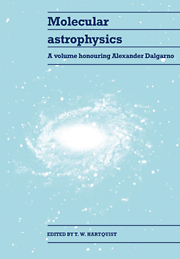Book contents
- Frontmatter
- Contents
- Dedication
- Preface
- Part I Molecular clouds and the distribution of molecules in the Milky Way and other galaxies
- Part II Diffuse molecular clouds
- Part III Quiescent dense clouds
- Part IV Studies of molecular processes
- Part V Atomic species in dense clouds
- Part VI H2 in regions of massive star formation
- Part VII Molecules near stars and in stellar ejecta
- 23 Masers in the envelopes of young and old stars
- 24 Chemistry in the circumstellar envelopes around mass-losing red giants
- 25 Atoms and molecules in Supernova 1987A
- Part VIII Moderately ionized gas and chemistry at large redshifts
- Index
25 - Atoms and molecules in Supernova 1987A
Published online by Cambridge University Press: 10 December 2009
- Frontmatter
- Contents
- Dedication
- Preface
- Part I Molecular clouds and the distribution of molecules in the Milky Way and other galaxies
- Part II Diffuse molecular clouds
- Part III Quiescent dense clouds
- Part IV Studies of molecular processes
- Part V Atomic species in dense clouds
- Part VI H2 in regions of massive star formation
- Part VII Molecules near stars and in stellar ejecta
- 23 Masers in the envelopes of young and old stars
- 24 Chemistry in the circumstellar envelopes around mass-losing red giants
- 25 Atoms and molecules in Supernova 1987A
- Part VIII Moderately ionized gas and chemistry at large redshifts
- Index
Summary
Introduction
It's a great pleasue for me to contribute to this volume in honor of Alex Dalgarno's 60th birthday. I first met Alex when I came to Harvard as an assistant professor in 1968. From these turbulent times up to now, Alex has been a very good friend and mentor to me. From Alex I gained an interest in atomic and molecular processes that has influenced my research ever since. My writing skills improved considerably by virtue of working with him. Most important, I am grateful to Alex for setting an example of what a good professor should be, not only as a scholar and teacher, but also as a generous and loyal friend to his students and colleagues.
With Supernova 1987A (February 23, 1987), nature has provided some birthday fireworks that will be a festive reminder of Alex's many important contributions to astrophysics. The brightest supernova since SN1604 (Kepler's supernova), SN1987A is the first one that has been observed in every electromagnetic wavelength band and it is the first one that will remain observable for several years as the debris clears away to allow a detailed view of its interior. Thus, SN1987A offers an unprecedented opportunity to infer details of supernova explosion dynamics and nucleosynthesis. This task presents fascinating and challenging problems in atomic and molecular astrophysics because, as I will describe, SN1987A is remarkably cool (≥7000 K) throughout its interior and there is good evidence that CO and SiO molecules have already formed there.
- Type
- Chapter
- Information
- Molecular AstrophysicsA Volume Honouring Alexander Dalgarno, pp. 439 - 458Publisher: Cambridge University PressPrint publication year: 1990

